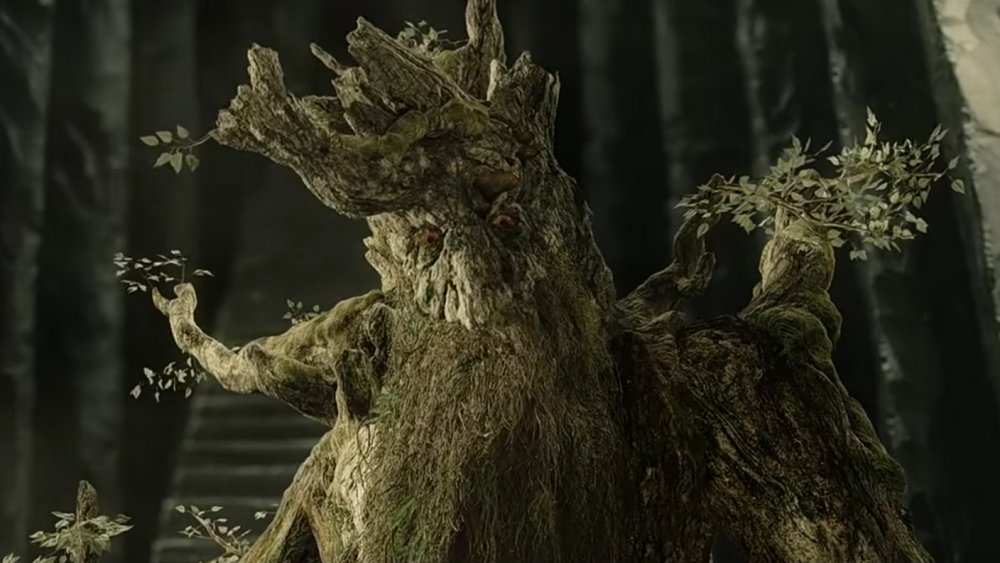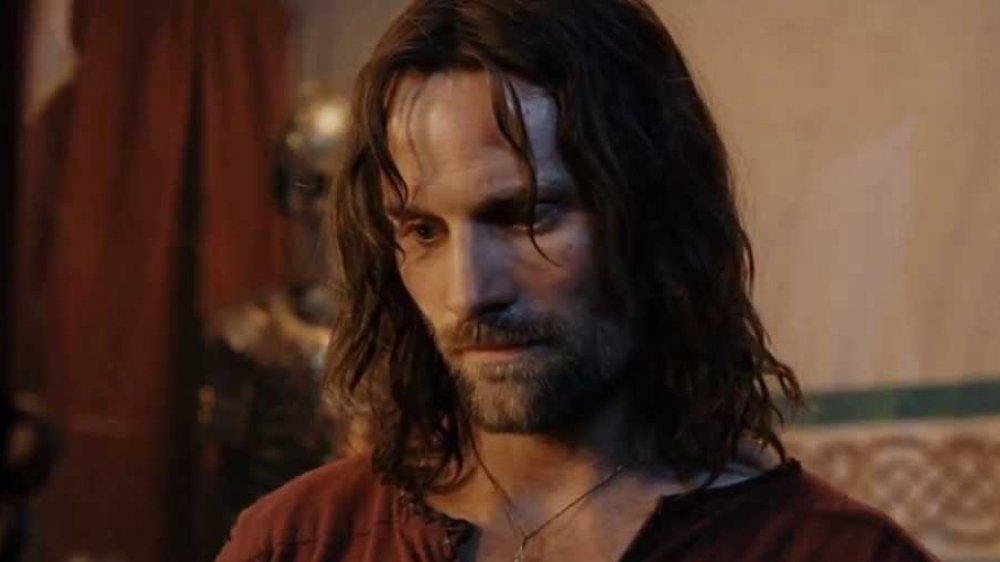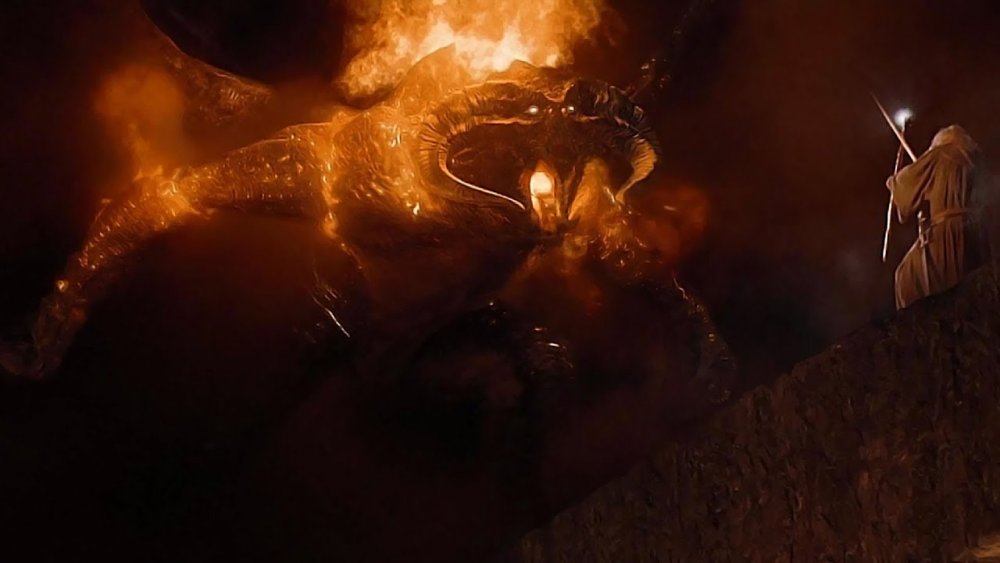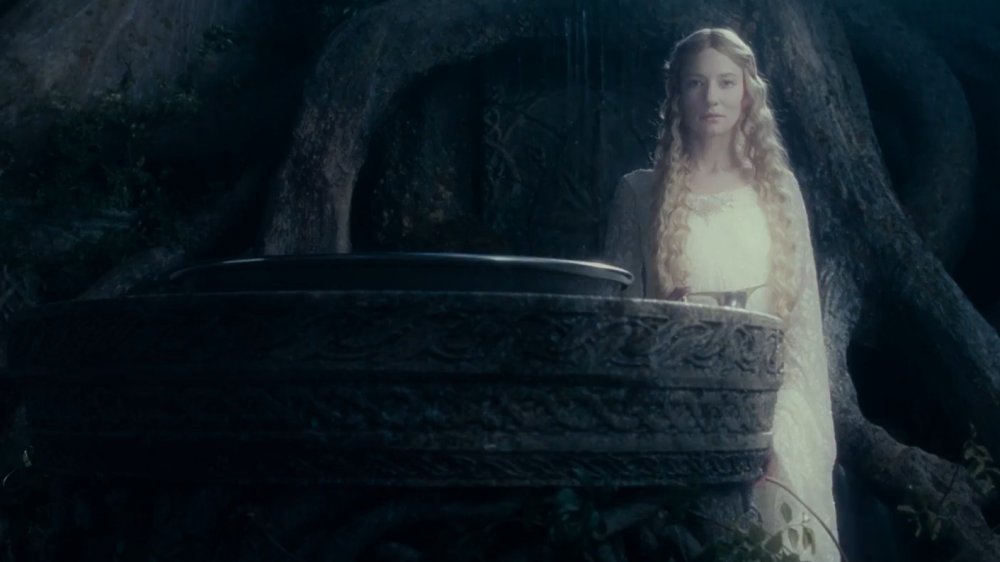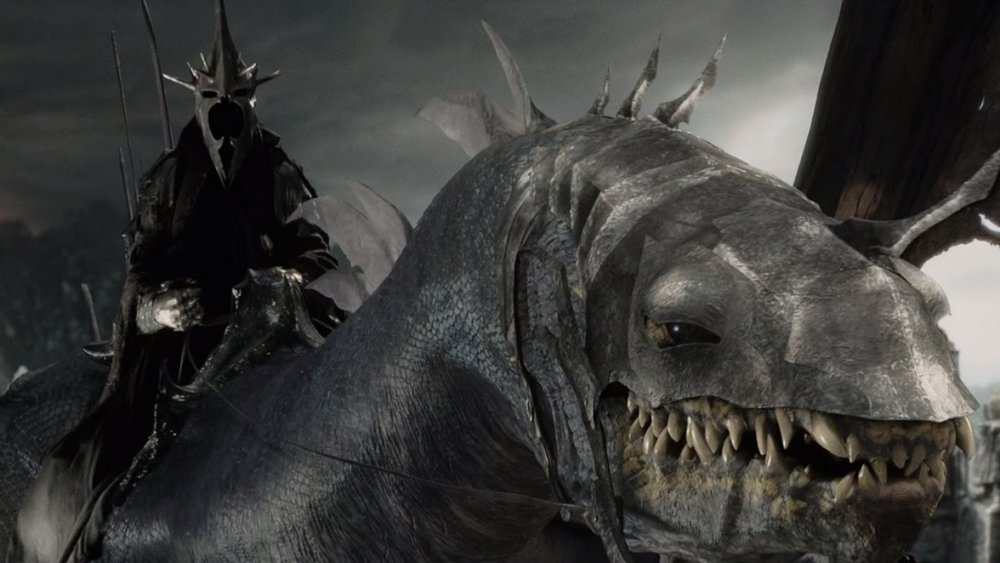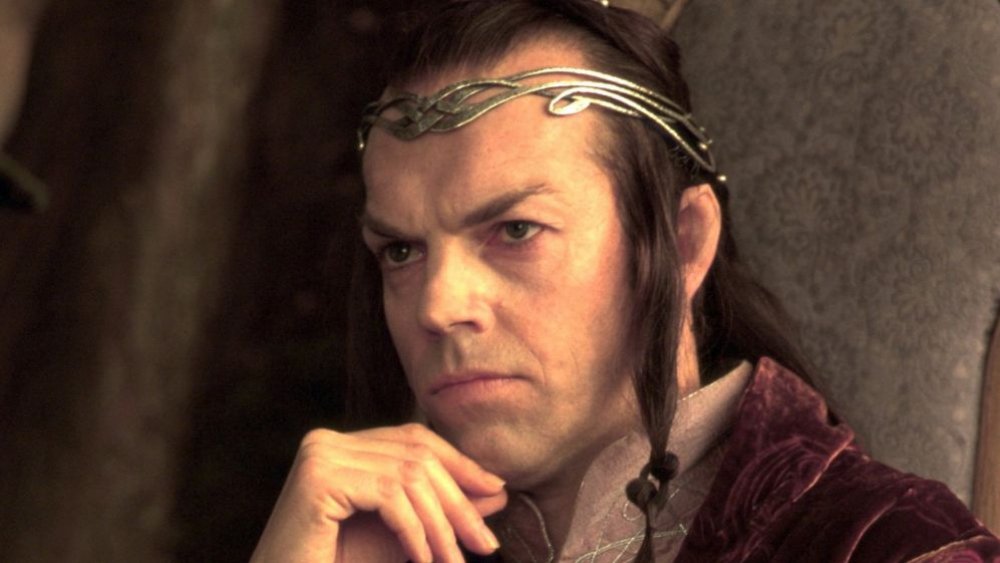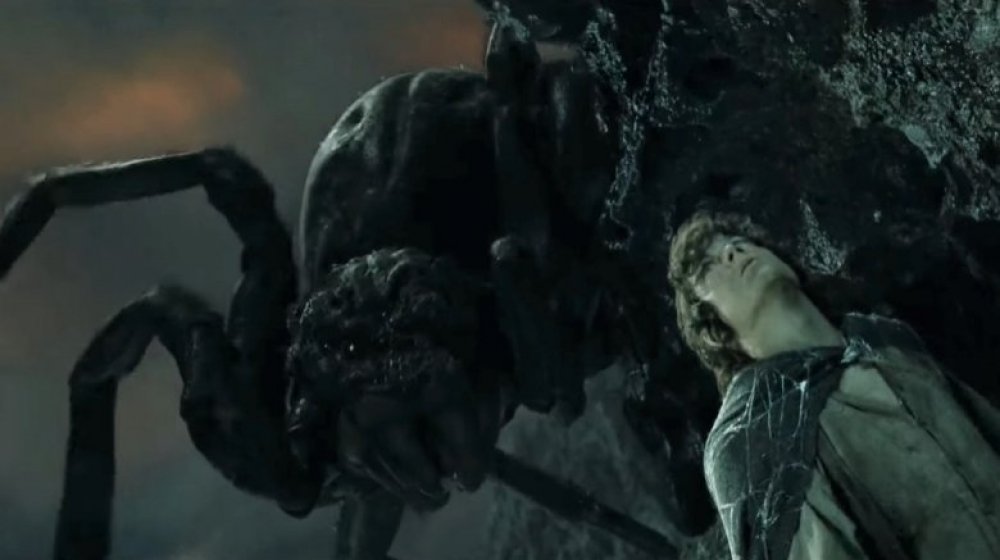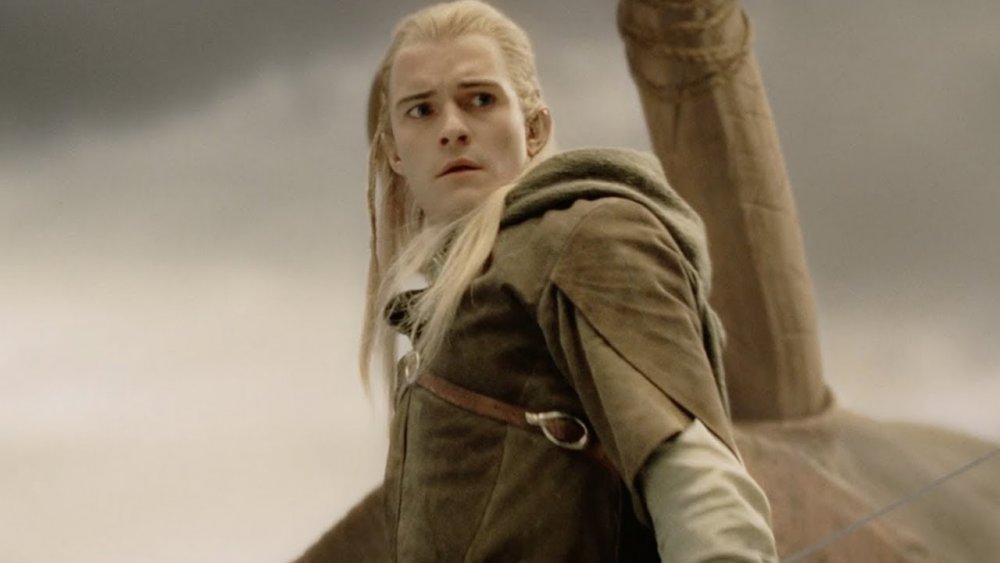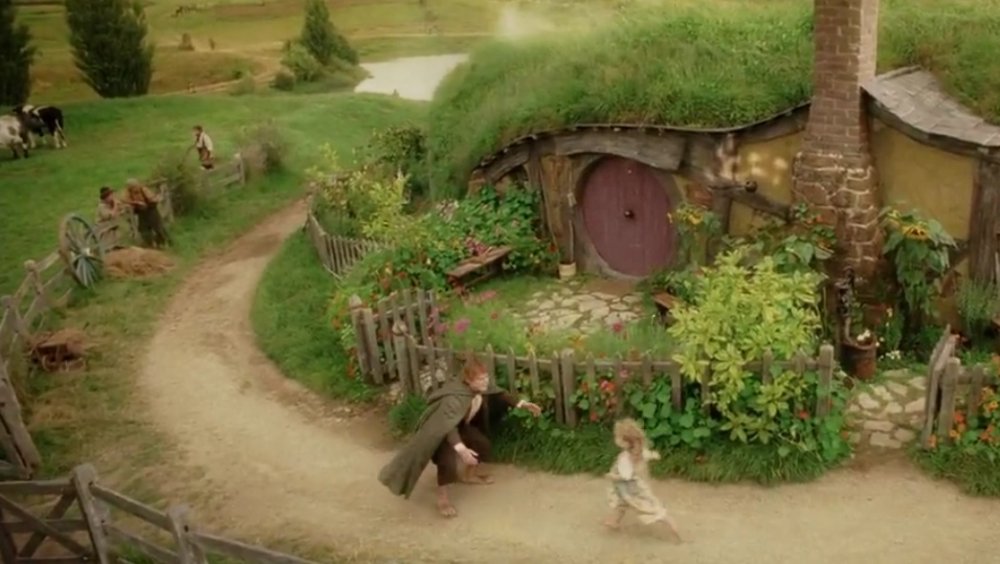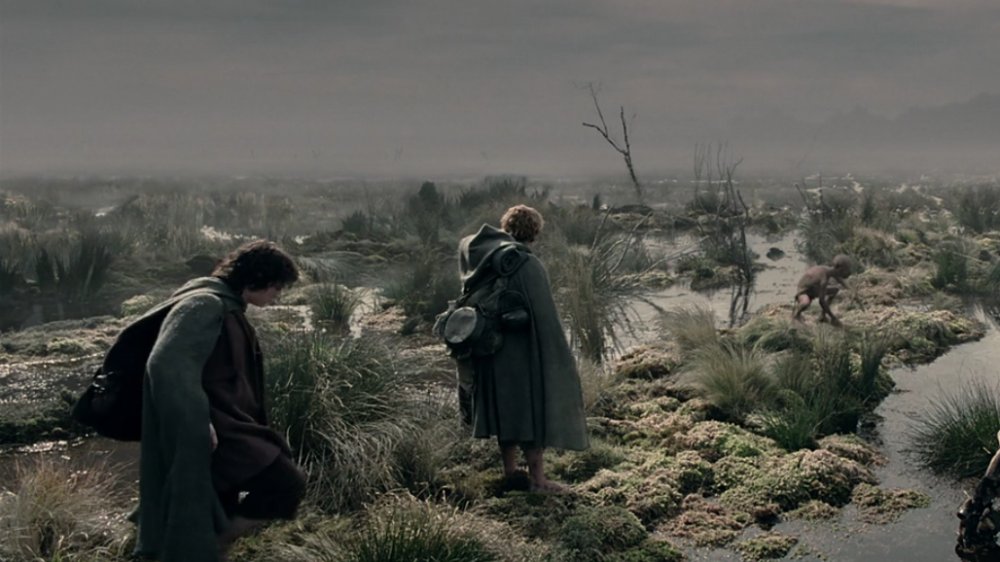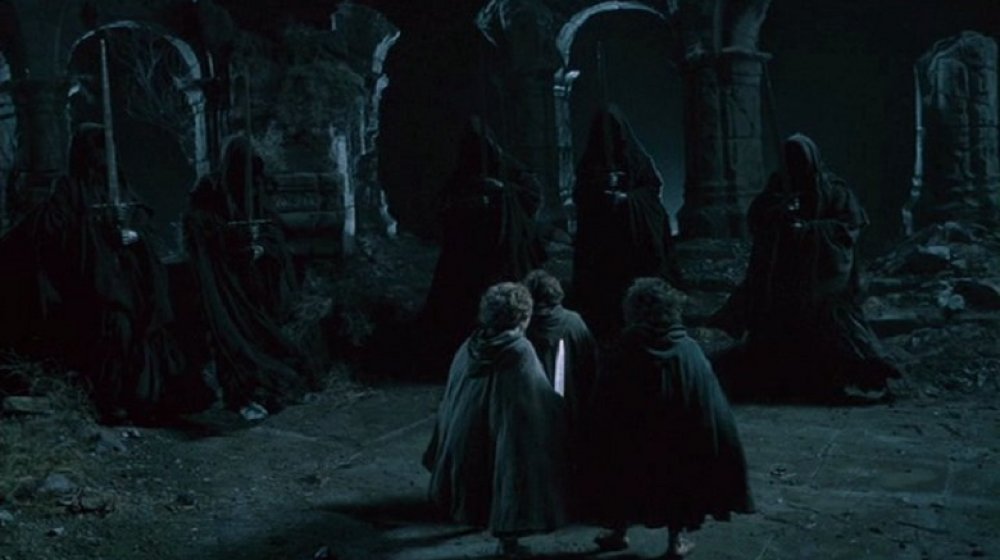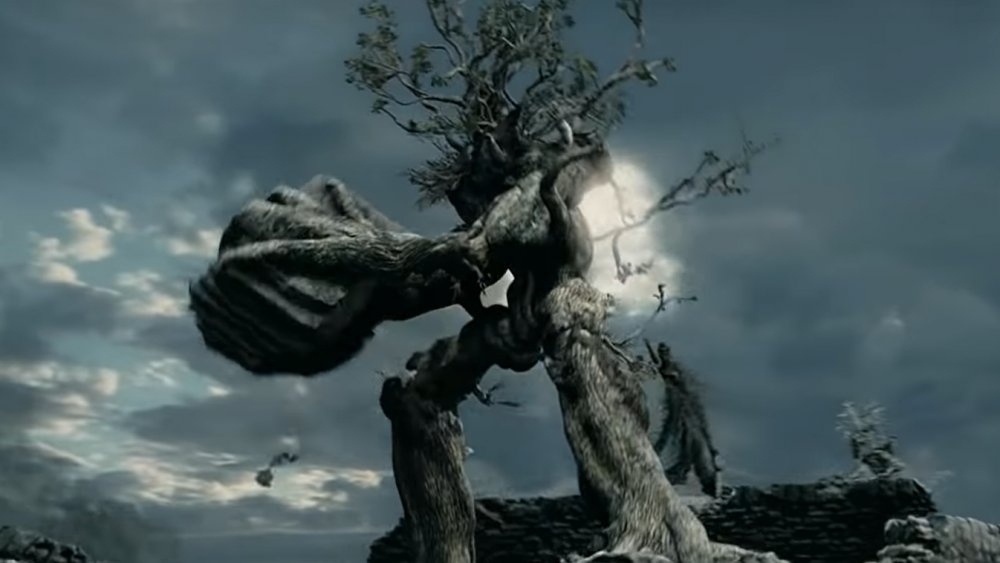Ways That Amazon's LOTR Prequel Could Connect To The Original Trilogy
Amazon's ridiculously expensive Lord of the Rings prequel project has been in the works for a while now. Production, which was temporarily held up by the COVID-19 pandemic, resumed in July 2020, reigniting fan's excitement as they endlessly wait with bated breath to see what tribute the streaming giant comes up with to add to Tolkien's legendarium.
Interestingly, around the time when filming fired up again, a leak hit the rumor mill (via We Got This Covered) claiming that the show would eventually connect to the original Lord of the Rings trilogy. Granted, it's just a rumor, but that said, it's certainly an exciting one. Previously, the only info in circulation had indicated that the show would exclusively take place in the Second Age, thousands of years before the primary LOTR trilogy takes place, and knowing that the Amazon crew may be looking for ways to connect the new material to the cinematic trilogy is an exciting development.
While we've already listed out the specific things that we want to see in the show, we thought we'd take a deeper dive into the Second Age to see what lines could be drawn in order to connect it to the Peter Jackson films. And we gotta say, if the rumor is true, there are some epic connections just waiting to be made.
Amazon's LOTR prequel could eventually connect to Aragorn's story
One of the original rumors for the series claimed that the show would revolve around a young Aragorn. This was exciting, as Aragorn's pre-LOTR resume is replete with romance, drama, and action. The exiled king loses his father at a young age, spends decades wandering in the wild, fights alongside Théoden's father in Rohan, delivers Gondor from an attack while in disguise, and gets Arwen to fall in love with him over the course of three decades. Needless to say, there's plenty of action to be had. The Walking Dead's Tom Payne stirred the waters even more when he casually mentioned that the show indeed was casting Aragorn.
And then the news dropped that the series would be set during the Second Age.
Now, Aragorn is no spring chicken. In fact, the ranger is 87 years young during The Lord of the Rings. Nevertheless, when it came out that the show was going to take place 3000-6000 years before the trilogy, it put the kibosh on the hopes that he would be involved in any capacity besides, maybe, a flash-forward. This new rumor, though, reignites the chances that we really will see a young Aragorn in all of his prepubescent (for a Númenórean king, at least) glory. In fact, from day one, it's been reported that Amazon also has the rights to a spin-off series along with the primary show. Perhaps they've found the man for the job? It'd be one heck of a way to connect to the original trilogy, that's for sure.
Amazon could show us how the Balrog got into Moria
Anyone who's watched The Lord of the Rings can't forget the spine-tingling scene when Gandalf stands on the Bridge of Khazad-dûm and defies the Balrog. When the fiery demon attempts to force the issue, it tumbles into the abyss, dragging the wizard along with him. Eventually, the pair end up on the top of the mountain, where the brute is thrown down, smiting the mountainside in his ruin.
While it's a satisfying conclusion, it doesn't answer one important question. Where the heck did this giant, fire-breathing monster come from? Fortunately, the Amazon show has a chance to answer that very question. See, back in the First Age of Middle-earth history, there are actually quite a lot of Balrogs running around and causing havoc. Most of these literal demons in physical form are defeated in the great War of Wrath that ends the age.
As the Second Age begins, one of the Balrogs flees from the catastrophe, looking for a place to hide. Eventually, it decides that it will bury itself deep in the subterranean passages under the Misty Mountains, nearby to the already established dwarven kingdom of Khazad-dûm. There, the creature would remain in cozy anonymity for several thousand years until far into the Third Age when the dwarves would run into it by accident during a mining expedition. If Amazon wants to connect their show to the original trilogy, what better way than to follow the origin story for the very Balrog that would eventually confront Gandalf in The Fellowship of the Ring?
Galadriel could visit Lothlorien for the first time
The elven lady Galadriel has already made her gracefully powerful presence known in both The Lord of the Rings and The Hobbit trilogies. It turns out that she's also one of the oldest beings in Middle-earth, clocking in at over 8,000 years old during the original trilogy. Obviously, this makes her an easy candidate to play a major role in the Amazon show. It's a fact that the studio clearly is aware of, too, since rumor has it that they already cast the character way back in late 2019.
This will be an excellent way to tie the original movies in with the new streaming series. Galadriel is a mover and a shaker throughout the Second Age, showing up more than once and getting involved in multiple storylines. She also gets her elven ring at this time, visits Rivendell, and generally hangs around the plot.
While Galadriel will already be a slam-dunk connection to the existing cinematic source material, the production team can take the affiliation even further if they want to. See, it's during the Second Age that Galadriel visits Lothlorien for the first time. Now, that doesn't mean she gets her magic aqua-mirror and becomes "the Lady of the Golden Wood" right there on the spot. However, she does pays her first visit to the woodland realm along with her daughter during the time that will be depicted in the show, making it an easy way to take the audience on a stroll down memory lane.
The Witch-king could play a big role
Anyone who's watched The Lord of the Rings is aware of the fact that the Witch-king of Angmar (that is, the chief of the Black Riders) is a badass of a dude. He heads up the hunt for the One Ring, stabs Frodo on Weathertop, leads Mordor's attack on Minas Tirith, confronts Gandalf in the gates of the city, and ultimately dies in an epic duel with Éowyn. From beginning to end, the fiend plays a pretty hefty role in the Ring saga.
However, it turns out that the trilogy is actually just his final act. The Witch-king has a terrifyingly impressive resume that stretches way back — right into the Second Age. In The Return of the King, Gandalf refers to the Witch-king as "the most fell of all [Sauron's] captains." He also calls him the "King of Angmar long ago, Sorcerer, Ringwraith, Lord of the Nazgûl." A lot of what Gandalf is referencing harkens back, thousands of years, to when Sauron initially helps create the Rings of Power in the middle of the Second Age.
When the Dark Lord gives nine of these rings to "Mortal Men doomed to die," the chief of these is the king of Angmar. In The Silmarillion, it states that Sauron particularly ensnares three "great lords of Númenórean race" — that is, the same line of men that Aragorn is descended from. This opens up a perfect opportunity for Amazon to set up an epic betrayal, leading to the early rise of the Witch-king.
Amazon could show us Elrond's backstory
When people think of Elrond, they typically picture a brooding elf, a grieved father, a ruminating councilor ... geez, this guy is downer a lot of the time. Seriously, though, apart from a quick scrape with Sauron in The Hobbit trilogy and some flashy leadership in the intro to The Fellowship of the Ring, Elrond is typically portrayed on the screen as a leader who doesn't get his hands dirty too often.
The thing is, by the time of the LOTR, Elrond is thousands of years old. He's born at the end of the First Age and, you guessed it, ends up playing a very hands-on role throughout the Second Age. Elrond is one of the few people who sees through Sauron's disguise when he "helps" the elves create the rings of power. He leads a portion of the armies that initially fight against the Dark Lord when he begins gathering said Rings of Power, too, and he even possesses one of the three elven Rings to boot. At one point, he's defeated and retreats northward where he establishes a little elven stronghold ... named Rivendell.
Elrond's new fortress holds out against Sauron and remains a key rallying point for thousands of years to come. Elrond also plays a pivotal role in the Last Alliance (that's the opening sequence in The Fellowship of the Ring) and remains busy in the struggle against Sauron. All in all, the elven lord provides an amazing opportunity for Amazon to tie a familiar face in with their otherwise largely disconnected story.
Mordor, Shelob, and the Drúedain, oh my!
By the time of The Lord of the Rings, Mordor has been a land of fear for millennia. Not forever, though. Sauron actually doesn't even settle in Mordor until roughly 1000 years into the Second Age. He forges the One Ring shortly after that and ends up sticking around for the rest of the next two ages.
Amazon can have fun with the Mordor setting throughout their show in a few different ways. First, it would be fun to see Sauron pick out his new home and settle down. On top of that, we should also be able to get a glimpse of everyone's favorite arachnid terror, Shelob, who should be well ensconced in her lair on the borders of the land during this time.
To top it all off, we may also get a glimpse into a race of men that only fans of the books are currently familiar with. In The Return of the King, the Rohirrim are secretly guided to Minas Tirith by a furtive group of stumpy, almost prehistoric-looking men called the Drúedain. These men originally are rumored to have come out of the land of Mordor back before it was evil, and they pop in and out of the larger narrative from time to time. To see this esoterically fascinating group of individuals finally make their stolid way onto the screen would be a treat.
Legolas is a bit of a wild card
Legolas Greenleaf is one of the most important yet utterly underdeveloped characters in all of Tolkien's mythology. The elven dude is a prince, a warrior, and a member of the Fellowship of the Ring. And yet, no one knows how old he is or, really, anything that he's done before the trilogy kicks off. It's unfortunate since Legolas is clearly a skilled and interesting character.
At the end of the day, though, this could end up being an unexpected boon for the team at Amazon Studios. The lack of backstory or history for the elven prince provides a possible opportunity to work him directly into the primary narrative without throwing things off from the source material too much. It would end up playing out a bit like his role in The Hobbit (a role that was completely fabricated for the films and never happened in the book, by the way). While Legolas' part in The Hobbit wasn't exactly a success — he often felt shoehorned into the plot — if Amazon is respectful of the character and careful not to overly integrate him, they could definitely use Legolas as a through line across the ages of Middle-earth history.
Could hobbits and the Shire be involved in the LOTR prequel?
Hobbits are an iconic, fun, central part of Tolkien's lore — in the Third Age, that is. Unfortunately, they aren't anywhere to be found during the Second Age. In fact, they don't even arrive in their homeland of the Shire until 1600 years after that age ends, although a bunch of elves, including Galadriel, do occupy the same area for a while during the Second Age. This means any meaningful part played by the good-hearted, hairy-footed people will either have to take place in flash-forwards or if the show progresses into the Third Age.
However, that hasn't stopped Frodo actor Elijah Wood from voicing his willingness to cameo in the show if they're willing to work in a role for him. He already did exactly that in The Hobbit films, appearing in a scene that jumps forward in time before the main story got rolling. That said, the original leak from We Got This Covered also pointed out that there will be some "big time jumps," which could be just the ticket to work in a scene with Frodo, Sam, or any of the other halflings in the middle of all the ancient storytelling.
Amazon could connect the story to the creation of the Dead Marshes
The Dead Marshes are pretty freaky. The swampy, haunted marshland lies to the northwest of Mordor, stretching for miles and miles in every direction. Gollum leads Sam and Frodo through this festering region on their way to Mordor, and Frodo has a very unpleasant encounter with a ghoul when he falls into the water. Eventually, the characters find their way out of the swamps and arrives at the Black Gate, leaving the randomly creepy episode in the rearview mirror.
The entire adventure begs the question, though, where did these haunted swamps come from? Fans of the books know that the wetlands used to be both smaller and less ghostly. However, at the end of the Second Age, during the Last Alliance — that's the opening sequence of The Fellowship of the Ring — a giant battle is fought next to and partly in the swampy land. Over time, the swamp spreads out, swallowing up the graves of the fallen warriors, including orcs, elves, and men alike, creating a damp, haunted plain in the process. The establishment of the Dead Marshes isn't just grossly fascinating, it also provides yet another way that Amazon could connect the events of their show with the adventures that take place in the original trilogy.
The LOTR prequel could show Weathertop in all its pre-ruinous glory
The ruins on top of Weathertop create the backdrop for one of Frodo's most harrowing adventures. In The Fellowship of the Ring, apparently abandoned by Aragorn and facing an attack from the Black Riders, Frodo and his hobbit friends seek protection by retreating to the ruins on the crest of the hill of Weathertop. There, they're attacked by five of the ringwraiths, and Frodo is stabbed with a poisoned blade before Aragorn arrives in the nick of time to save them.
It turns out that those ruins aren't just a bunch of rubble. We're seeing the remains of a fortress that was originally built thousands of years earlier when Aragorn's Númenórean ancestors arrived in Middle-earth and began setting up the sister kingdoms of Gondor in the south and Arnor in the north. Weathertop is in Arnor, and the hill initially has a giant tower built on top of it as a key fortress of the northern kingdom. Not only is the fortress important, but it even has one of the seven palantíri or "seeing stones" — the same stones that Saruman and Sauron eventually steal and use to communicate in The Lord of the Rings. Weathertop becomes a bigger deal in the Third Age — in fact, it becomes the centerpiece of a civil war — and it's a top candidate to find its way into the Amazon iteration.
Amazon could give us the ents' tragic backstory
Treebeard and the ents are a mesmerizing part of The Lord of the Rings mythos. The shepherds of the trees demonstrate an oxymoronic balance of slow, gentle behavior and impressively destructive aggression depending on the time and the place. But while the ents' primary story is associated with the original trilogy, they actually experience an epic tragedy a long time before that tale ever gets started.
Created early on to help protect the trees, the ents maintain a presence in Middle-earth throughout its long, calamitous history. Early on, though, they're not alone. The male "ents" are accompanied by female "entwives." While they love one another, the ents remain focused on caring for larger trees while the entwives pay attention to ordering smaller plants, grasses, flowers, and gardens. Eventually, their estrangement leads to a physical separation. The ents remain in the woods, and the entwives relocate to the Brown Lands between Mordor and Mirkwood.
At an undisclosed point, the ents go to visit the entwives and find that Sauron has destroyed their beautifully ordered homeland. The entwives are gone, and the ents search far and wide for their mates. They never recover from the bereavement and have still not found the entwives when the LOTR trilogy takes place. While it isn't explicitly stated when the tragedy of the ents and the entwives takes place, there might be enough leeway in the story to enable Amazon to integrate the tragic tale into their own story, as well.
